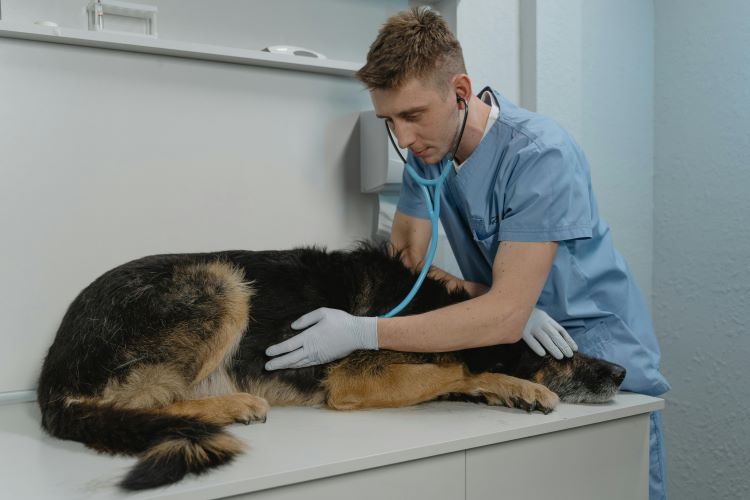Ready to help treat your pet to a healthy life?
Navigating Pancreatitis in Dogs: Signs, Diagnosis & Possible Outcomes
By : Trupanion Staff | Updated Apr 1, 2025

Learning your dog may have a serious health condition like pancreatitis is something no pet parent ever wants to hear. Pancreatitis in dogs is a serious and potentially life-threatening condition that occurs when the pancreas becomes inflamed. When this happens, your dog can suffer from a variety of symptoms and may even be at risk of organ damage.
Although it is a serious illness, canine pancreatitis can be managed or even cured in many cases. If your dog is at risk or has recently been diagnosed with pancreatitis, it’s crucial that you work with their veterinarian for a treatment plan. But to help you become more informed and gain some peace of mind, we’ll go over what exactly dog pancreatitis is, as well as its causes, symptoms, treatment options, and preventive measures.
The importance of your dog’s pancreas
Unless your vet has brought it up specifically before, there’s a good chance you’re like many dog owners and just haven’t thought much about your pet’s pancreas and what it does. The pancreas is an elongated, L-shaped glandular organ (sometimes just called a gland) in your dog’s abdominal cavity. It is located on the right side of the abdomen, adjacent to the stomach and is considered part of both the digestive and endocrine systems. It functions just like a human pancreas does, though it should go without saying that it is a bit smaller and shaped specifically for your pup’s body.
The pancreas is considered an essential organ, meaning your pet cannot live without it and needs it functioning properly to survive and thrive. It’s also a unique organ in that it serves important purposes for both the endocrine and exocrine systems of the body:
- Endocrine function — The endocrine tissue of the pancreas produces insulin and glucagon, two hormones that regulate blood glucose levels.
- Exocrine function — Pancreatic exocrine tissue produces digestive enzymes, including amylase and lipase, which are secreted into the small intestine to break food down into basic nutrients that can be absorbed into the bloodstream.
What is canine pancreatitis?
As established above, your dog’s pancreas plays a crucial role in their body’s digestion and blood sugar regulation. But when it malfunctions, it can cause severe symptoms and may even lead to organ damage and death. Canine pancreatitis — inflammation of the pancreas — is a serious health condition that requires swift veterinary treatment.
Though inflammation may not sound so bad by itself, it’s what’s behind the swelling that’s so dangerous for your pup. Pancreatitis causes premature activation of digestive enzymes that directly damage pancreatic tissue, causing, in addition to swelling and inflammation, internal bleeding and tissue death. This damage causes the production of inflammatory chemicals which, along with activated enzymes, circulate through the bloodstream to cause negative body-wide effects. These dangerous effects can include:
- Generalized inflammation (in areas around the body, not just the pancreas)
- Disseminated intravascular coagulation (DIC), which is characterized by blood clotting in the vessels, and is associated with a poor prognosis
- Neurologic damage
- Hypotension
- Multi-organ failure
Pancreatitis’ potentially severe systemic effects, particularly organ failure and DIC, can cause death in some advanced cases.
Though it often seems to come on suddenly and out of the blue, the truth is that pancreatitis often start subtly and progresses if left untreated. There are also many causes and risk factors for dogs.
Causes
If your dog is suffering from pancreatitis, only their veterinarian will be able to determine the likely cause. That said, causes of dog pancreatitis include (but are not necessarily limited to) the following:
- Ingestion of a high-fat meal — Release of a surge of enzymes after a high-fat meal can cause pancreatic inflammation. A rise in pancreatitis cases is often observed after holidays, such as Thanksgiving and Christmas, when pets are treated to fatty leftovers.
- Genetics — Certain dog breeds such as Miniature Schnauzers, Cocker Spaniels, Poodles, Dachshunds, Yorkshire Terriers, and sledding breeds have a higher incidence of pancreatitis.
- High blood-triglyceride levels — High circulating cholesterol levels can stimulate the pancreas to release more digestive enzymes, which can trigger inflammation.
- Trauma — Blunt trauma to the abdomen, such as injuries received when a pet is hit by a car, can incite pancreatic inflammation.
- Additional Causes — Other endocrine diseases or ingestion of drugs or toxins can also contribute to the development of dog pancreatitis. Pancreatitis can be triggered by high-fat diets, obesity, certain medications, or underlying health conditions.
Signs of dog pancreatitis
It can be very stressful thinking your dog may have pancreatitis. But before you start jumping to any conclusions, learn the signs to watch for and seek veterinary attention right away if you notice anything is off with your pet. The good news is that many common signs of pancreatitis in dogs are similar to other, milder illnesses. However, it’s still important to get a proper diagnosis to rule out serious health conditions.
Pancreatitis can cause clinical signs in dogs, ranging from mild to severe. These may include:
- Unexplained weight loss
- Loss of appetite
- Vomiting
- Weakness
- Abdominal pain (your dog may react painfully or flinch when touched)
- Dehydration
- Diarrhea
- Fever
- Bloated appearance
Mild pancreatitis cases may likewise cause subtle clinical signs that are not obvious. Left untreated, these cases can progress to severe conditions and be life-threatening. Again, seek veterinary attention right away if you notice something is wrong.

Treating pancreatitis in dogs
Your veterinarian is always the best resource for information on your dog’s condition and their specific treatment options. That said, it can be comforting to learn that there are effective treatments and management options for many stages of the illness.
Before any of that starts, your veterinarian will need to confirm that your pet’s condition is pancreatitis and not another health condition. They may run a series of tests to do so. Diagnosis of canine pancreatitis may include anything from X-rays and/or ultrasounds of your dog’s abdomen to blood tests. They may also run a Canine Pancreatic Lipase Immunoreactivity test or cPLI, which measures levels of certain enzymes associated with the condition.
Once pancreatitis is confirmed, your vet will need to determine the severity and cause. By the time they are diagnosed, most dog pancreatitis cases require hospitalization with aggressive monitoring. The significant inflammation and systemic effects caused by pancreatitis require several treatments and medications to manage clinical signs and potentially devastating effects, and may include:
- Intravenous fluids to correct dehydration caused by vomiting and diarrhea
- Medications to control nausea and vomiting
- Medications to control abdominal pain
- Anti-inflammatory medications to reduce pancreatic and system inflammation
- Antibiotics
- Nutritional support
- Plasma transfusions
- Treatment of any systemic complications
- Stringent monitoring until your dog reaches a certain level of improvement
Your pet’s veterinary team will assess their condition and come up with a treatment plan specific to them. While the above treatments are listed as examples, your dog’s options will vary depending on the severity of their condition, what’s causing it, and what your veterinarian thinks is the best course of action.
Possible outcomes
The good news is that most dogs with pancreatitis go on to make a full recovery with proper treatment. And while most cases do require hospitalization, dogs will typically be able to finish treatments at home if they show signs of improvement after several days.
Severe cases that cause significant pancreatic necrosis can result in scar tissue formation and loss of pancreatic endocrine and exocrine function. Two conditions that are possible consequences of a severe bout of pancreatitis for dogs include:
- Diabetes mellitus — Loss of pancreatic endocrine function can result in insufficient insulin production. Without adequate insulin, glucose from digested food cannot be taken into cells to produce energy for the body’s functions.
- Exocrine pancreatic insufficiency (EPI) — Loss of exocrine pancreatic function causes inadequate digestive enzyme production. Affected dogs have difficulty breaking down fats, and enzyme supplements are required for proper digestion.
Although most cases do not advance to this point, the potential severity of dog pancreatitis cannot be stressed enough. Death is a possibility with this condition, providing a critical reason for early, aggressive treatment with your veterinarian.
Does pet insurance cover canine pancreatitis?
It may come as no surprise that pancreatitis in dogs can incur some pretty steep veterinary costs. Fortunately, the right dog insurance can help lessen the financial burden. Generally speaking, pancreatitis is covered under a good pet insurance policy, like Trupanion. Eligible costs may include diagnostic tests as well as treatment (including hospital stays).
That said, pancreatitis in your dog will not be covered if it can be considered a pre-existing condition. This is why it is so important to sign up for pet insurance while your dog is young and without a long history of health issues. Doing so will allow coverage not just for pancreatitis, but other new and unexpected health conditions that could come your pet’s way in the future.

Can pancreatitis in dogs be prevented?
There is no guarantee that your dog won’t get pancreatitis, even with the best care (which is all the more reason to sign up for a dog insurance plan while they’re young and healthy). However, there are some things you can do as a responsible, caring pet parent to help reduce their chances. Much of this revolves around dietary choices and making sure your pup is only exposed to healthy food items.
Specifically, preventing pancreatitis in dogs involves a healthy diet, weight management, and avoiding harmful foods. Avoid giving dogs high-fat treats or human foods like bacon, sausage, or fried items, and ensure they don’t get into trash or counter-surf for dangerous foods.
Last but certainly not least, routine veterinary care is key. Regular check-ups will help monitor your dog’s overall health and can catch early signs of issues like pancreatitis. For dog breeds who may be at higher risk of the condition, keeping up with routine vet visits are all the more important. The bottom line? Make healthy choices for your dog’s lifestyle, stay on top of their medical care, and don’t hesitate to reach out to your vet if something seems amiss.
Like learning about canine health and veterinary care? Find out what to expect during pet surgery.
